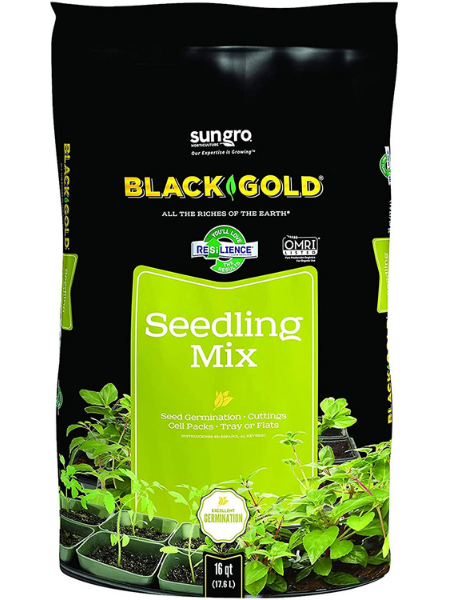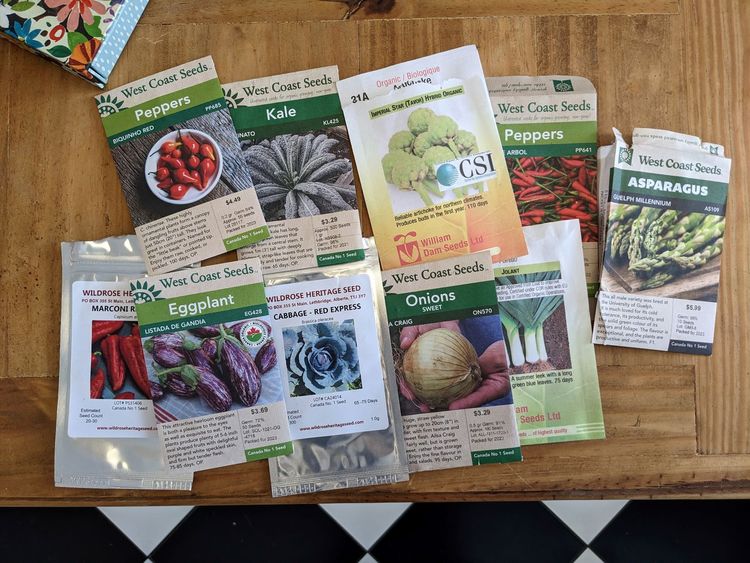Recipe for a DIY Seedling Starting Mix

Take your home grown plants to the next level with a high quality seedling starting mix that you make yourself.
Over the years, I've had real issues with premade seedling starting mix in terms of quality, not being able to find out what exactly is in them and cost. Some bagged mixes will have ingredient lists, some won't, and the same brands can often be inconsistent between bags of mix. I also found that, where I am at least, it was not always easy to find a seedling starting mix at a reasonable price. For all these reasons, I have been making my own seedling starting mix which I now use most of the time for my seed starts, with great results so far!
What's in a seedling starting mix?
For me, there are three important characteristics to a seedling starting mix that will give you big, healthy plants ready to go in the garden. Seedling starting mixes should:
1: Have good aeration
2: Have water retention
3: Have some fertility.
The third point is maybe controversial, but I'll talk a bit about that later. Often the premade mixes you buy at the garden center won't have any fertility added to them. Let's take a look at the ingredients of a popular mix, Black Gold Natural Seedling Mix for an example.

The ingredients here are:
- Sphagnum peat moss - This is the water retention component and makes up most of the mix. It will absorb water and prevent the seedlings from drying out too quickly.
- Perlite - This is the aeration part of the mix. It keeps the mix light and prevents it from compacting too much, allowing plant roots to grow easily. The air space created by the perlite also allows water to drain, meaning while your mix will still be moist, your seedlings' roots won't be waterlogged.
- Organic Wetting Agent - This is included because peat moss can be difficult to wet on it's own when it's very dry and the wetting agent speeds up the process. Peat moss will eventually absorb water without a wetting agent however when the moisture level is high enough.
- RESiLiENCE - This is Sungro's proprietary version of silicone dioxide and is included because it may improve root growth, make plants take longer to wilt and allow them to bounce back more quickly from infrequent watering.
No added fertility in this mix, but you could use it and it would probably work well enough to get your seeds going. Most of your seedlings' initial nutrition is going to be coming from the seeds themselves and not from what the plant is growing in, so a mix with no extra nutrients will be enough to get them going.
However, I think it's important to make sure there are some extra micronutrients (these are the chemicals that plants need in very small amounts, like vitamins in people) and some light fertilization available, so that your plants are more able to continue their growth. This is particularly important if you have seedlings that will spend a longer time in a pot before they go in the garden, like peppers or tomatoes, as they'll be getting to a larger size before being transplanted.
When I talk about fertility in seed starting mixes, I am not adding any fertilizers with a lot of nitrogen, phosphorus or potassium (the NPK you see on fertilizer labels). I like to use compost and worm castings that provide only a small amount of NPK and which add some microbial life to the mix. I also include amendments like greensand or basalt rock dust, because they provide trace mineral micronutrients that plants need to grow healthy and to be ready to transplant out into the garden.
My seedling starting mix recipe
When I make my seedling mix, I use whatever components are cheap and accessible where I live. I keep the measurements approximate with a big 6 gallon bucket and mix the components all together in a big plastic container with a lid that I then store it in. This all is to make my life easier and I can quickly make some mix in bulk to have it last me a while.
So keeping these things in mind, here is the recipe that I use:
- 1/3 drainage component - This can be perlite, vermiculite or pumice. I would avoid using sand as this makes for a very heavy mix that will compact more than you want.
- 1/3 water retention component - This can be peat moss or coconut coir.
- 1/3 fertility/filler component - I use primarily compost for this part of the mix. The best compost is the stuff you produce at home, but any kind of balanced, mature compost is fine. If I have some worm castings, I will add them to be 5-10% of the total mix volume. I also add a tablespoon or two of the greensand or rock dust I mentioned before as a mineral amendment to the mix.
If you have a soil sifter or wire mesh screen available it can be worthwhile to sift your mix when you transfer it to whatever you'll be growing your seeds in, to get rid of any of the large chunks and bits of woody material. I usually skip this part though and use my hands to break up or remove any of the chunks that are on the planting area surface.
The bagged seed starting mixes you'll typically buy will be sterile, which has the advantage that you won't have any insects hatching out in your grow area and there's no chance you'll have to deal with dampening off. This is a condition where your seedlings are weakened or killed off by pathogens in the soil, becoming more of an issue with cold, damp conditions.
I've been using this unsterilized mix for a while and have never had any issues and other than the occasional little fly hatching out, my seedlings have more or less always been healthy. I also think it's strange to grow your seedlings in a sterile growing medium, when they'll eventually be plopped in a very unsterile environment like the garden later. If you grow your seedlings indoors, in a cold frame or in a greenhouse you have a lot of ability to control you seedlings' environment and that can prevent issues like dampening off from ever occurring.
A seedling starting mix is generally lighter than potting mix, with fewer large chunks and less woody material. Potting mixes will have more compost, even soil and often some kind of fertilizer included in them as well.
I know I'm blurring the lines here with my starting mix recipe, but it has worked really well for me so far!
BONUS - Boost your premade bagged seedling starting mix
If you already have some bagged seedling starting mix and want to give it a bit of a boost, I recommend adding 5-10% of the worm castings to it. Adding a small amount of greensand or rock dust also goes a long way! This adds a bit of fertility, some microbial activity and micronutrients. It makes the environment your seedlings are developing in more like the one they'll be transplanted into when they go in the garden.
Take the time to make your own seedling starting mix and you'll find that you might save yourself some money and end up with some healthier plants as well! Contact me with any questions, ideas or seed starting mix recipes of your own!


